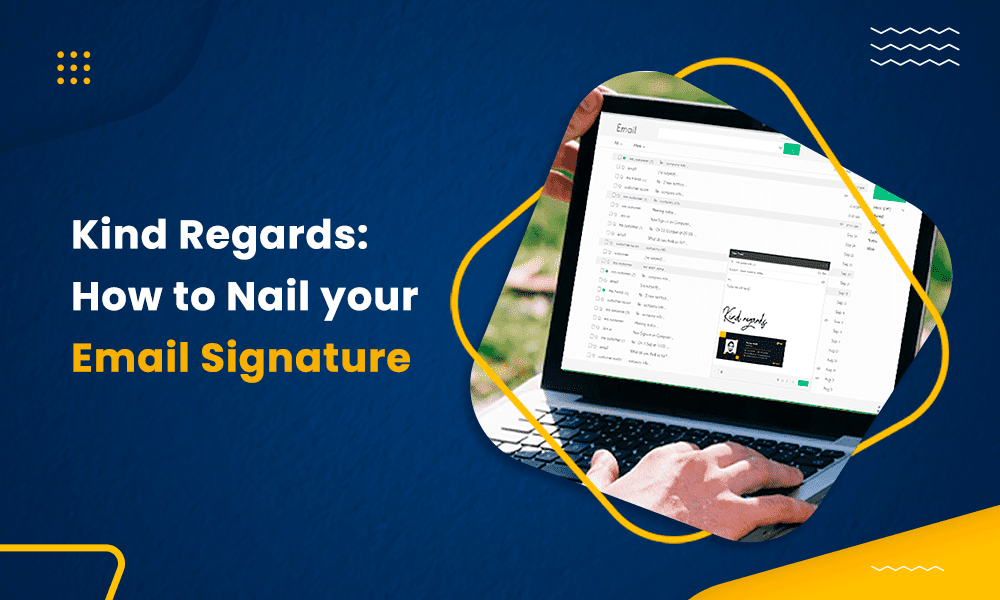While closing an email, you need to sign off.
But what is the right way to do it? Should you write ‘Kind Regards,’ ‘Best Regards,’ ‘Warm Regards,’ or, for that matter, only ‘Regards’?
Similarly, there are many other sign-off options that can confuse you even further.
An email sign-off is a short phrase added to your email’s end, right before your contact information.
Just like a salutation indicates the beginning of your email, a sign-off indicates its end. Including a sign-off reflects good email etiquette on the part of the sender.
In this article, we will look at the best and worst ways to sign off an email. I’ll also share some best practices to nail your overall email signature style.
But before that, let’s understand the importance of a good email sign-off.
Table of Contents
Why a Good Email Sign-off Is a Must
A good email sign-off makes your email look more professional.
No matter how well-written your body content is, without a salutation or a sign-off, your email recipient may be disappointed. The closing phrase of your written correspondence should make an impact.
Email is one of the most effective communication channels because it’s personal. You lose the personal element by omitting a sign-off or using the wrong one.
Here’s an example of how Robin Sharma, the author of the best-selling book ‘The Monk Who Sold His Ferrari,’ signs off for his newsletter subscribers.
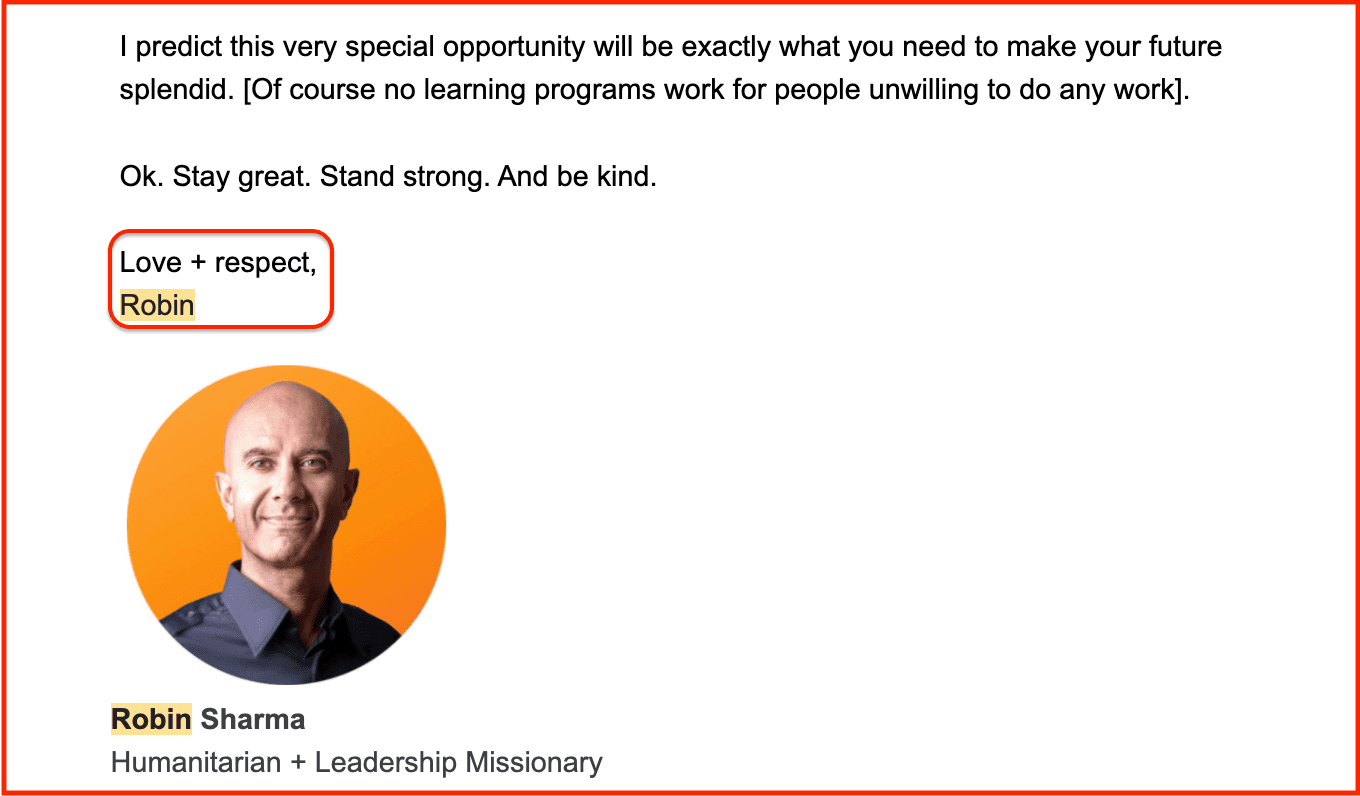
‘Love + Respect’ is a unique way of signing off. It easily connects with its recipients, which helps build better relationships with them.
But again, this might not go well with a professional email.
As it’s the last thing your subscribers read in your email, it tends to stick in their minds.
That’s why it’s crucial to look at the right ways to sign off an email.
Best and Worst Ways to Sign Off Your Emails
Some email sign-offs get a higher response rate than others.
Emails that are signed off with a ‘Thanks in advance’ and ‘Thanks’ have seen response rates of 65.7% and 63%, respectively.
Whereas emails that signed off with ‘Kind Regards’ had a response rate of 53.9%, ‘Best Regards’ and ‘Regards’ had 52.9% and 53.5%, respectively.
Here are some of the best and worst ways to sign off your emails.
#1. Best Regards
A commonly used sign-off, ‘Best Regards’ sets a friendly tone with clients and people you aren’t well acquainted with and is a great alternative to using ‘Kind Regards’.
Typically, ‘Best Regards’ indicates respect and admiration for the recipient without indicating any working relationship other than what you already have with them.
But that doesn’t limit you from using it while communicating with your existing clients, vendors, or colleagues within the company.
Typical scenarios where you can use Best Regards:
- when someone sending you an email already uses a more casual language
- when communicating with businesses and vendors you already have an established relationship with
- when reaching out to your colleagues
- when emailing existing customers
For example, here’s an email I got from LinkedIn. With no direct relation with LinkedIn, it uses ‘Best Regards’ to establish a sense of gratitude in case I decide to take the survey.
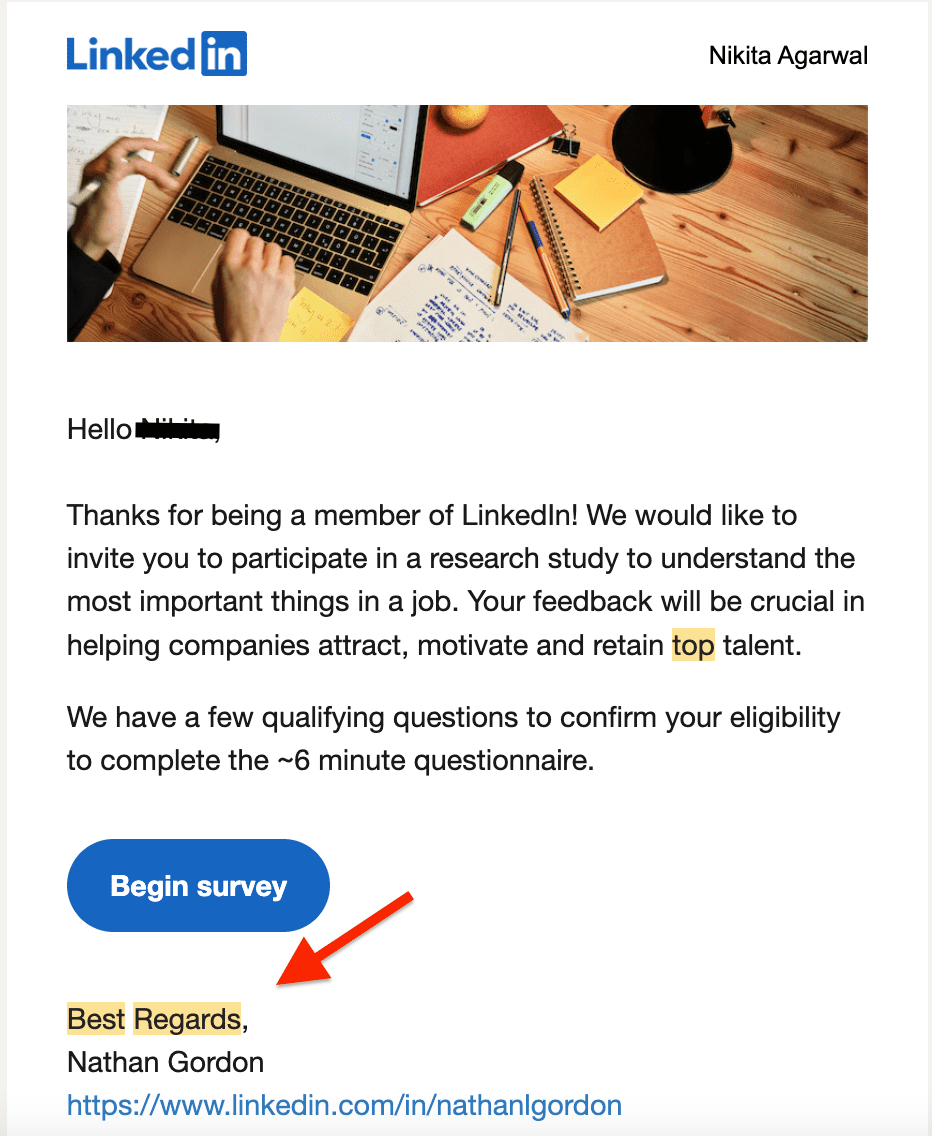
Read also: B2B Email Marketing Examples From Billion Dollar Companies
#2. Kind Regards
Are you emailing someone for the first time? Use ‘Kind Regards’ to sign off.
While the formal tone may sound less friendly, it conveys authority and professionalism.
Typical scenarios where you can use the Kind Regards signature:
- When sending welcome or introductory emails to a mutual acquaintance of your friend
- During the early stages of your communication with prospects and leads
- During a warm outreach campaign
- When you’re unsure which signature to choose from
Variations include Kindest Regards, Warm Regards, or just Regards.
Read also: How To Write Discount Emails Like A Boss
#3. Thanks and Regards
‘Thanks and Regards’ sets a professional yet friendly tone.
While it sounds formal, it also addresses your recipient with respect.
This is how our onboarding team at EngageBay makes the best use of Thanks and Regards’ sign-off.
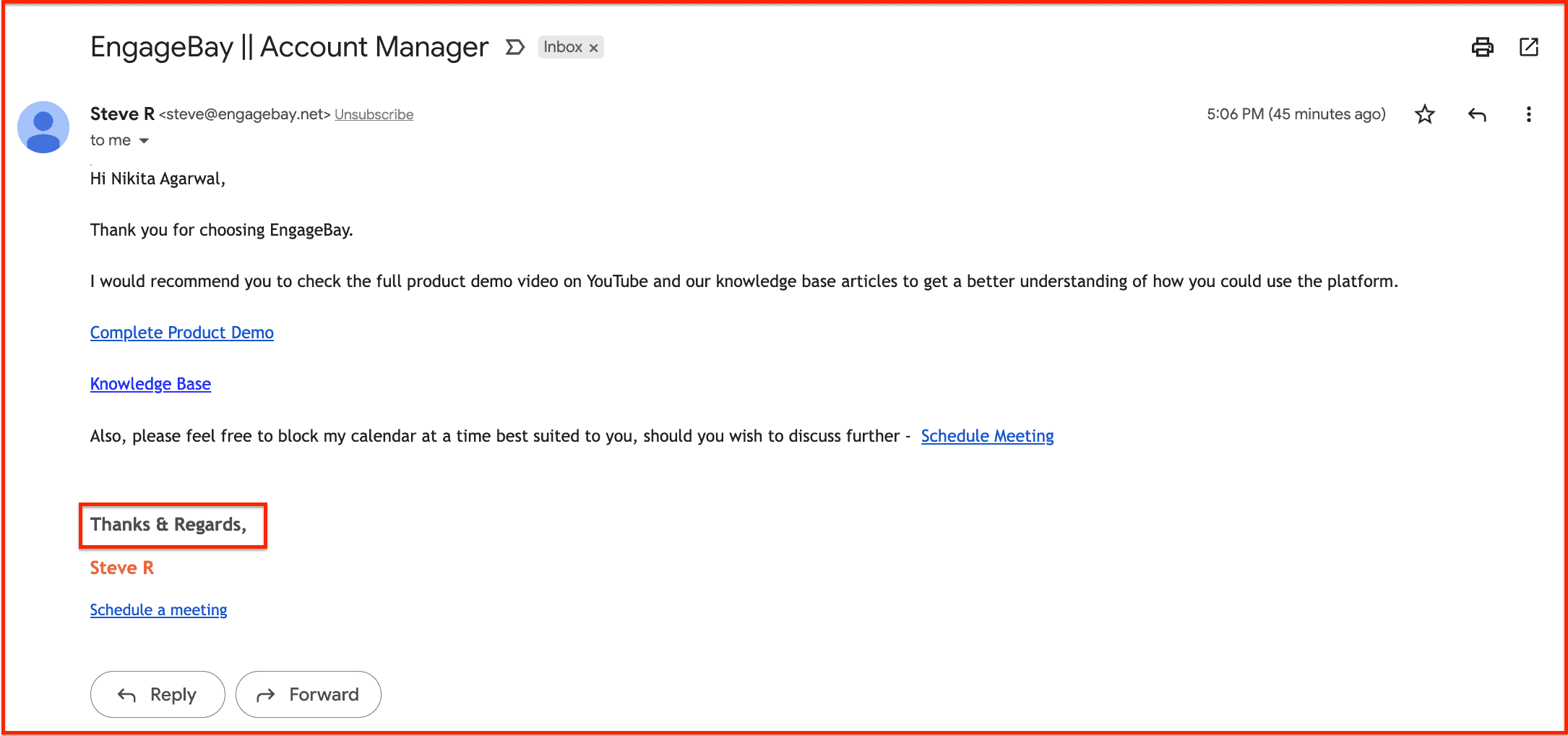
#4. Regards
When in doubt, always use ‘Regards.’
Even though ‘Regards’ sets a professional tone, it does not create any expectations. ‘Kind Regards’ and ‘Best Regards’ can be used both in professional and informal situations — so when you’re unsure which salutation to choose from, go with ‘Regards’.
Probably why it is one of the most popular ways to sign off despite risking sounding rude or cold.
Hence, before using it, understand who your recipient is, your relationship with them, and the purpose of your personal or business email.
Read also: How to Write a Winning Introduction Email
#5. Best
Another professional yet friendly sign-off, ‘Best’ can be used in almost all kinds of scenarios.
Use it when sending an email to your friend, colleague, professor, or your manager.
It’s better to avoid using ‘Best’ if you are contacting someone for the first time or in a more formal setting.
#6. Thank you or Thanks
If someone has offered guidance or assistance, close your email with a ‘Thank You’ or ‘Thanks.’
A ‘Thank You’ acknowledges the work done by the recipient and has a tone of appreciation, making it a great alternative to Kind Regards / Best Regards.
Moreover, you can also close your informal email with a ‘Thank You’ to ask someone to perform a task, resolve a query, or provide answers to a question.
Read also: How To Say ‘Please Find Attached’ In 20 Different, Smarter Ways
#7. Great working with you
If you are sending an email thanking someone for their services, then a ‘Great working with you’ is a good way to sign off.
You can also use this sign-off when you want to send a farewell email to a colleague who is leaving the organization.
#8. Looking forward
‘Looking forward’ is a warm and gracious way to show your eagerness to meet or hear from your recipient.
It is generally used when you want to discuss ideas with a colleague and get their input or feedback.
#9. Best wishes
‘Best Wishes’ is more like a greeting used in email while trying to send good wishes to your recipient for any occasion or event.
For instance, if you are trying to send your employee a welcome or farewell email, ‘Best Wishes’ will be the right sign-off.
It helps establish a friendly tone with the recipient. An alternative for Best Wishes is Warm Wishes.
Read also: 12 Email Invoice Templates to Customize and Click Send
#10. Hope this helps
When you reply to someone who has asked a question or for some kind of help, you can use ‘Hope this helps’ to sign off your email.
You can also use the sign-off if you are providing someone with potentially useful information or resources.
#11. Take care
Another way to build a friendly relationship with colleagues is by closing your emails with a ‘Take care.’
However, keep in mind that this is an informal way to communicate with your colleagues, so it is best to use it only with people with whom you are well acquainted. This is also a good option while sending personal emails to colleagues from the same organization.
Besides, ‘Take Care’ is often used to address sick leave request emails at the workplace.
How to Write PS in Email: A Guide For Good Writing
How Not to Sign Off Your Emails
Learning how not to sign off your emails is as important as knowing how to sign off. Here are five of the worst ones.
Let’s dive in.
#12. Sent from my iPhone
This is one of the worst ways to sign off formal emails.
Unless you want to tell the world that you own an iPhone, make sure that you avoid signing off with a ‘Sent from my iPhone.’
Not only does it come across as unprofessional, but it shows a lack of effort and respect for the recipient.
How to remove the ‘Sent from iPhone’ signature from your emails
Follow this simple guide to remove the signature.
Open Settings: Open the Settings app on your iPhone. Scroll down until you find the Mail option. Tap on it to open the Mail settings.
Select ‘Signature’: Within the Mail settings, look for an option called ‘Signature’. It’s typically located under the ‘Composing’ section.
Edit or Remove the Signature: In the ‘Signature’ section, you’ll see a box displaying your current email signature. If the ‘Sent from iPhone’ signature is there, you can edit or remove it entirely.
Remove or Modify the Text: Tap on the text box to edit or delete the existing signature. If you want to remove it, delete the text. If you want to change it, modify it to your preference.
Save Changes: After making changes, be sure to save them.
#13. Emojis
Often, people use a smiley face to close their emails.
While using emojis when emailing friends might be alright, it is best not to use them while communicating with colleagues or clients.
Avoid using emojis or smiley faces in your professional email signatures and sign-offs if you want to come across as a professional person.
Read also: 15 Introduction Email Templates That Work Like A Charm
#14. Using just your name
Signing off an email with just your name reflects unprofessionalism.
It generally conveys that you are not interested in communicating with your recipient.
This may not be a good sign for your business communication.
#15. Thx/Thnx/Rgds/XoXo
While today’s generation may be familiar with short forms and abbreviations, it gives a negative impression in the business world.
Not only would it be confusing for your recipients to understand the sign-offs, but it also indicates an unprofessional and lax attitude.
#16. Thanks so much
Avoid using ‘Thanks so much’ unless you want to thank someone for helping.
It is unprofessional and grammatically incorrect.
If you want to say thank you over email, use ‘Thank You’ or ‘Thanks’ instead.
Read also: 11 Proven Ways To Build An Email List (Still Working)
Best Practices to Nail Your Email Signature
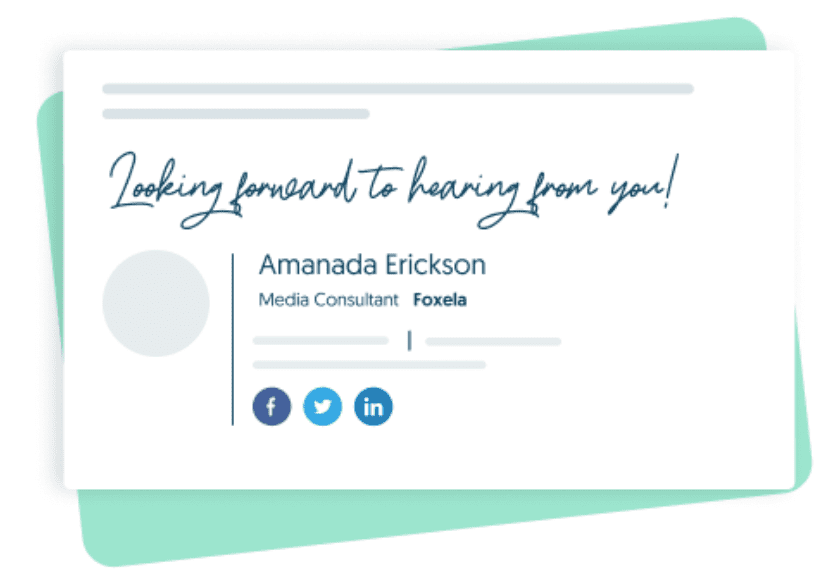
Here are some tips that you can follow and ace your email signatures.
#1. Understand your recipient
The first step before closing an email is understanding your relationship with the recipient.
If you are emailing a friend or a teammate, it might be alright to use informal sign-offs such as ‘Thanks,’ ‘Best,’ ‘Take Care,’ or ‘Best Wishes.’
However, if you are sending an email to your manager, a senior colleague, or someone you don’t know, it is ideal to use more formal sign-offs like ‘Best Regards,’ ‘Kind Regards,’ ‘Regards,’ or ‘Thanks and Regards.’
Read also: 12 Email Invoice Templates to Customize and Click Send
#2. Write your full name
Irrespective of whether it is your first or fifth email, it is preferable to state your full name in your sign-off.
Unless you have a unique name or are well-acquainted with the receiver, use your full name at all times.
#3. Include contact details
To nurture a relationship with your recipients, make sure that you include relevant contact information while closing your emails.
Details such as your phone number, company website, and social media handles can allow people to contact you beyond emails as well.
#4. Avoid unprofessional language
To develop good email etiquette, make sure that you sign off all your emails.
Not including a sign-off makes your emails abrupt and unprofessional.
Irrespective of whether the sender signed off their emails, ensure that you do so at all times.
Also, try to avoid abbreviations and the use of informal language.
Read also: How to Create a Cold Email Strategy That Will Hook Your Readers
Wrap Up
Email sign-offs don’t just demonstrate a positive work ethic but good email etiquette as well.
There are several ways to sign off your emails, depending upon the situation and the recipient.
There are many websites that allow you to build an email signature for free. You can also find a wide range of templates to help you get started.
Most of these websites are simple to use. All you need to do is enter your details and select a color combination palette, and you are good to go.
For email tracking, email broadcasts, email automation, and email templates, you can always try the #1 affordable alternative to HubSpot — EngageBay.
Signing off,
Nikita

